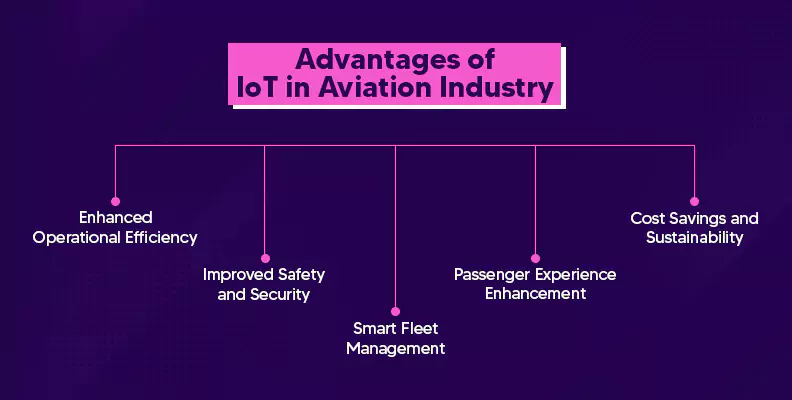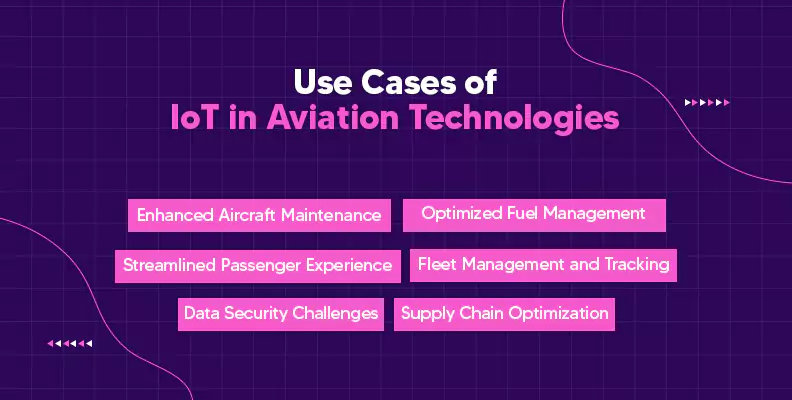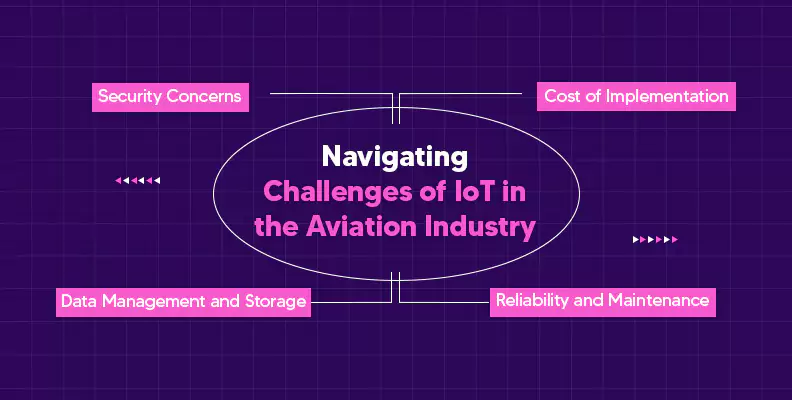Loading.....
The Digital Takeoff : IoT's Impact on the Aviation Technologies

In the ever-evolving landscape of technology, the Internet of Things (IoT) has emerged as a revolutionary force, transforming various industries. One sector where IoT is making significant strides is aviation. The integration of IoT in aviation brings forth a wave of innovation, enhancing safety, efficiency, and overall operational excellence. This blog revolves around the profound impact of IoT on the aviation industry and explores how it is shaping the future of air travel.
Meaning of IoT in Aviation
The Internet of Things refers to the interconnected network of devices, vehicles, and other objects embedded with sensors, software, and network connectivity, enabling them to collect and exchange data. This interconnected web of devices facilitates seamless communication and real-time data sharing, leading to improved efficiency and productivity.
In the aviation industry, IoT plays a pivotal role in enhancing safety, efficiency, and overall operational effectiveness. Aircraft, ground support equipment, and various components within the aviation ecosystem are equipped with sensors and communication devices, creating a smart and interconnected network.
Advantages

- Enhanced Operational Efficiency
- Improved Safety and Security
- Smart Fleet Management
- Passenger Experience Enhancement
- Cost Savings and Sustainability
Use Cases of IoT in Aviation Technologies

-
Enhanced Aircraft Maintenance
IoT sensors are now an integral part of aircraft components, continuously monitoring and collecting data on various parameters such as engine health, fuel efficiency, and system performance. This real-time data allows for predictive maintenance, reducing downtime and improving overall safety. Airlines can address potential issues before they escalate, resulting in significant cost savings and increased operational efficiency. -
Optimized Fuel Management
Fuel consumption accounts for a substantial portion of an airline's operating costs. IoT devices assist in optimizing fuel management by providing real-time data on fuel levels, engine efficiency, and flight trajectories. Airlines can make informed decisions to enhance fuel efficiency, reduce emissions, and minimize the environmental impact of air travel. -
Streamlined Passenger Experience
IoT is revolutionizing the passenger experience from check-in to arrival. Smart airports leverage IoT devices to enhance security, automate check-in processes, and provide real-time updates on flight status. Inside the aircraft, IoT contributes to in-flight entertainment systems, personalized services, and efficient cabin management. This not only improves the overall travel experience but also enables airlines to differentiate themselves in a competitive market. -
Fleet Management and Tracking
Airlines manage vast fleets of aircraft scattered across the globe. IoT-enabled tracking systems allow for real-time monitoring of each aircraft's location, performance, and health. This ensures better fleet management, optimized scheduling, and improved route planning. Additionally, in case of emergencies, quick response times are possible with precise location data. -
Data Security Challenges
While IoT brings numerous benefits, it also introduces cybersecurity challenges. With the interconnected nature of IoT devices, the aviation industry needs to prioritize robust cybersecurity measures. Ensuring the integrity and confidentiality of data transmitted between devices is crucial to prevent potential threats that could compromise safety and operational efficiency. -
Supply Chain Optimization
Efficient supply chain management is critical for the smooth operation of any airline. Airlines incorporated IoT to optimize their supply chain processes, from procurement to inventory management. Smart sensors were deployed in warehouses to monitor stock levels, track the movement of spare parts, and ensure timely replenishment.
Navigating Challenges of IoT in the Aviation Industry
While IoT has shown tremendous potential in enhancing safety, efficiency, and overall operational capabilities, it is not without its roadblocks. In this blog post, we will delve into the challenges that the aviation industry faces in implementing IoT solutions.

-
Security Concerns: Security is a paramount concern in the aviation industry, and the introduction
of IoT devices adds a layer of
complexity. With a multitude of interconnected devices collecting and sharing data, the vulnerability to
cyber threats
increases. Ensuring robust cybersecurity measures is crucial to safeguard sensitive information and
prevent potential
disruptions to flight operations.
👉 Solution: Implementing advanced encryption protocols, regularly updating software, and conducting comprehensive cybersecurity training for staff can help mitigate security risks.
-
Data Management and Storage: IoT devices generate massive volumes of data, and efficiently managing
and storing this information is a significant
challenge. The aviation industry needs robust systems to process, analyze, and store data in real-time to
derive
actionable insights. Inadequate data management can lead to delays in decision-making and compromise the
effectiveness
of IoT applications.
👉 Solution: Investing in scalable cloud infrastructure and advanced data analytics tools can help manage and process large datasets efficiently.
-
Cost of Implementation: The deployment of IoT in the aviation sector involves significant upfront
costs.
This includes the expenses associated
with acquiring and installing IoT devices, upgrading infrastructure, and training personnel. For many
aviation
companies, especially smaller ones, the financial burden can be a major roadblock to adopting IoT
technology.
👉 Solution: Conducting a thorough cost-benefit analysis and exploring government incentives or industry collaborations can help mitigate the financial challenges associated with IoT implementation.
-
Reliability and Maintenance: The reliability of IoT devices is critical in the aviation industry,
where precision and accuracy are non-negotiable.
Regular maintenance and updates are essential to ensure the proper functioning of IoT devices. However,
the logistics of
maintaining a vast network of interconnected devices present operational challenges.
👉 Solution: Implementing proactive maintenance schedules, remote monitoring, and utilizing predictive maintenance technologies can enhance the reliability and longevity of IoT devices.
Conclusion
The integration of IoT in aviation brings a multitude of advantages that ripple across various facets of the industry. From enhancing operational efficiency to revolutionizing the passenger experience, IoT technologies are reshaping the future of aviation.
However, as with any revolutionary technology, IoT in aviation comes with its set of challenges. By acknowledging these challenges and presenting potential solutions, the aviation industry can navigate through obstacles and harness the full potential of IoT.
In conclusion, IoT is steering the aviation industry towards a future of unparalleled connectivity, efficiency, and safety. As airlines continue to embrace and implement IoT solutions, it is imperative to address challenges and foster collaboration between industry stakeholders and regulatory bodies. By doing so, the aviation sector can soar to new heights, offering passengers a safer, more efficient, and seamless travel experience in the interconnected skies of the 21st century.
 Back to blog
Back to blog












